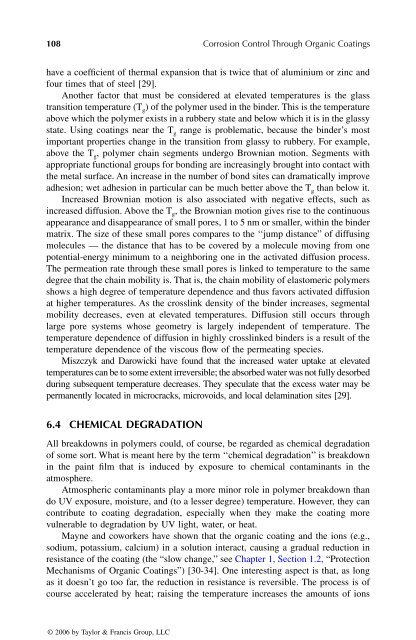© 2006 by Taylor & Francis Group, LLC
© 2006 by Taylor & Francis Group, LLC
© 2006 by Taylor & Francis Group, LLC
You also want an ePaper? Increase the reach of your titles
YUMPU automatically turns print PDFs into web optimized ePapers that Google loves.
108 Corrosion Control Through Organic Coatings<br />
have a coefficient of thermal expansion that is twice that of aluminium or zinc and<br />
four times that of steel [29].<br />
Another factor that must be considered at elevated temperatures is the glass<br />
transition temperature (T g) of the polymer used in the binder. This is the temperature<br />
above which the polymer exists in a rubbery state and below which it is in the glassy<br />
state. Using coatings near the T g range is problematic, because the binder’s most<br />
important properties change in the transition from glassy to rubbery. For example,<br />
above the T g, polymer chain segments undergo Brownian motion. Segments with<br />
appropriate functional groups for bonding are increasingly brought into contact with<br />
the metal surface. An increase in the number of bond sites can dramatically improve<br />
adhesion; wet adhesion in particular can be much better above the T g than below it.<br />
Increased Brownian motion is also associated with negative effects, such as<br />
increased diffusion. Above the T g, the Brownian motion gives rise to the continuous<br />
appearance and disappearance of small pores, 1 to 5 nm or smaller, within the binder<br />
matrix. The size of these small pores compares to the ‘‘jump distance” of diffusing<br />
molecules — the distance that has to be covered <strong>by</strong> a molecule moving from one<br />
potential-energy minimum to a neighboring one in the activated diffusion process.<br />
The permeation rate through these small pores is linked to temperature to the same<br />
degree that the chain mobility is. That is, the chain mobility of elastomeric polymers<br />
shows a high degree of temperature dependence and thus favors activated diffusion<br />
at higher temperatures. As the crosslink density of the binder increases, segmental<br />
mobility decreases, even at elevated temperatures. Diffusion still occurs through<br />
large pore systems whose geometry is largely independent of temperature. The<br />
temperature dependence of diffusion in highly crosslinked binders is a result of the<br />
temperature dependence of the viscous flow of the permeating species.<br />
Miszczyk and Darowicki have found that the increased water uptake at elevated<br />
temperatures can be to some extent irreversible; the absorbed water was not fully desorbed<br />
during subsequent temperature decreases. They speculate that the excess water may be<br />
permanently located in microcracks, microvoids, and local delamination sites [29].<br />
6.4 CHEMICAL DEGRADATION<br />
All breakdowns in polymers could, of course, be regarded as chemical degradation<br />
of some sort. What is meant here <strong>by</strong> the term ‘‘chemical degradation’’ is breakdown<br />
in the paint film that is induced <strong>by</strong> exposure to chemical contaminants in the<br />
atmosphere.<br />
Atmospheric contaminants play a more minor role in polymer breakdown than<br />
do UV exposure, moisture, and (to a lesser degree) temperature. However, they can<br />
contribute to coating degradation, especially when they make the coating more<br />
vulnerable to degradation <strong>by</strong> UV light, water, or heat.<br />
Mayne and coworkers have shown that the organic coating and the ions (e.g.,<br />
sodium, potassium, calcium) in a solution interact, causing a gradual reduction in<br />
resistance of the coating (the “slow change,” see Chapter 1, Section 1.2, “Protection<br />
Mechanisms of Organic Coatings”) [30-34]. One interesting aspect is that, as long<br />
as it doesn’t go too far, the reduction in resistance is reversible. The process is of<br />
course accelerated <strong>by</strong> heat; raising the temperature increases the amounts of ions<br />
<strong>©</strong> <strong>2006</strong> <strong>by</strong> <strong>Taylor</strong> & <strong>Francis</strong> <strong>Group</strong>, <strong>LLC</strong>
















